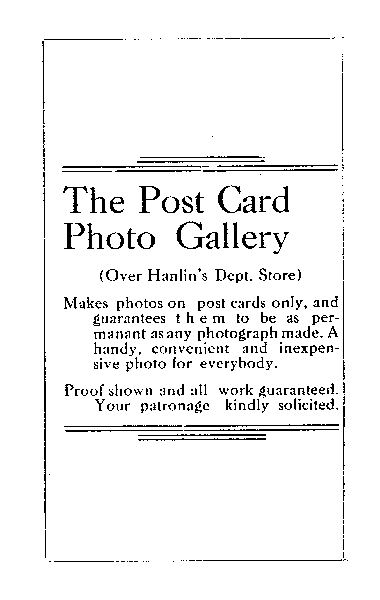
Advertisement for the Post Card Photo Gallery in Newton. Echoes (1911)
 March 2002
vol. 57 no. 1
Back to Table of Contents
March 2002
vol. 57 no. 1
Back to Table of Contents
Postcard historians get to do all kinds of interesting things. They go to postcard shows, antique stores, and auctions, and they find time to check around on the internet, especially for the eBay auctions, all in the name of "historical research." And with the postcards, they get to read other people's mail. (1)
Although not taken very seriously by many academic historians, postcard collecting has become a distinct field of scholarship, with its own methodology, magazines, meetings, and vocabulary. Postcard collectors have given themselves a fancy Greek-inspired name, Deltiologists. Tom Phillips, author of The Postcard Century, somewhat skeptical of such elegant terminology, referred to the effort "to hoist a hobby from the junkshop dust into a vocation and a science." (2) The picture side of a postcard reveals much about the life and times of a period. The message side gives short snippets of information about the daily happenings of ordinary people. Sometimes the message is very short indeed, only "Please write," or "How are you?" At other times, a mass of information is crammed into the little space. When postcards appeared, they became for many people the most common means of long-distance communication. Post office service was dependable, mail deliveries frequent (two to five deliveries a day), and stamps were cheap. Phillips called the early cards "the phone call" of the day, "the mode of making arrangements, placing orders, or just keeping in touch." (3) The twentieth century was the great "postcard century."
The study of postcard history can easily be applied to Bethel College, since the two histories parallel each other. Bethel got its charter in 1887 and its campus in Newton opened for classes in 1893. The Main or Administration Building was completed the same year. Post cards had a nearly similar history. England led the way in using unwrapped or public mail cards, issuing the first post cards in 1870; the United States followed in 1873. These were, however, plain pieces of paper without the characteristic pictures expected today. Post office regulations in various countries gradually allowed picture cards, and the internationally accepted size was set at 5 ½ by 3 ½ inches. (4) In 1893, the year when Bethel launched its new college at Newton, the United States issued its first official picture post cards and sold them at the Columbian Exposition in Chicago. These early cards (pre-1907) are easily recognizable by the ink scrawls on the front side. During those years, the stamped side was undivided ("this side is exclusively for the address"). Any written message had to be squeezed on the picture side. The American picture post card took on its modern appearance in 1907 (the English in 1902) when the address side was divided and a place for the message was provided on the back side. By the time Bethel began functioning in 1893, the postcard had become a regular part of American life. Bethel faculty and students followed the trend.
Many alumni have a collection of Bethel College memorabilia, often including some postcards. If postcards are made the focus of collecting, they make an unusual window into the history of Bethel. The Sprunger collection of Bethel cards has gradually accumulated during more than thirty-eight years of teaching at Bethel and by now consists of about 140 cards. Other collections of Bethel postcards are much larger. The Mennonite Library and Archives has by far the largest collection of Bethel cards, several hundred at least, and several local collectors have many Bethel cards, plus general Newton cards. Dudley Dodgion Toews in his Newton Remembering Yesterday Today included reproductions of many local postcards, including some from Bethel College. (5) The internet is also a rich source. The internet site, "Harvey County, Kansas, Photo & Postcard Collection," organized by Julie Welty, shows over forty cards, including Bethel College. (For on-line resources about postcards, see the Appendix at the end of the article).
From nearly its first day, Bethel people used postcards. Some of these came from commercial postcard firms for souvenir and mail purposes. In addition, many postcards were "real photo" cards produced from black and white photographs of both professional photographers and amateur Brownie Kodak fans. These were printed on special photo paper that had a pre-printed postcard back side for address and message. This format became especially popular about 1907 when Kodak and other companies began selling cameras that used film the size of a postcard and also sold printing paper with pre-printed postcard backs. (6) Newton, Kansas also had at least one photo business, the Post Card Photo Gallery, that specialized in printing real photo cards. Aiming for student clients, it offered its services in Echoes, the Bethel yearbook.

Advertisement for the Post Card Photo Gallery in Newton. Echoes (1911)
Some Bethel camera buffs, apparently, had all of their photos printed on postcard paper in case they wished to send them out in the mail. Most real photo cards are rare, since they may exist in only one copy from one roll of film. For many postcard collectors the real photo card is in a class by itself, the "king"of cards. (7)
The Olga Neuenschwander Collection. Included in the Sprunger Collection are the photo postcards from the photo album and autograph book of one particular student, Olga Erna Neuenschwander (Olie Schwander), 1891-1962, from Berne, Indiana. She was the daughter of Katherine Lehman Neuenschwander and David C. Neuenschwander, song leader and music director at the First Mennonite Church of Berne. (8) Olga's brother Milo preceded her at Bethel, graduating from the Academy in 1911; Olga was a student at Bethel in 1911-1913 and graduated from the Academy program with the two-year English Academic class of '13.
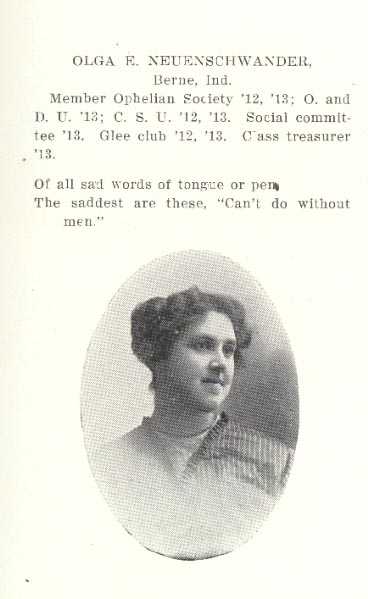
Illustration B. Olga Neuenschwander's graduation picture in Echoes (1913)
The yearbook listing of activities showed her to be a joiner of clubs and organizations, the Ophelian Society, the Oratorical and Debating Society, the Student Christian Union, the Social Committee, the Glee Club, and she was class secretary. Likely, she knew everyone and everything that happened on campus.
After school, she returned to Berne and married Ernest J. Stengel, a local druggist. She often assisted by clerking in the Stengel Drug Store. (9) Her Bethel mementoes (including over 50 real photo postcards) went into the attic and remained there until the house was sold in the 1970s. At that time, the new owner recognized their historical importance and delivered them to Bethel's history professor, an old school friend. (10) In addition to the Post Card Album there is an autograph book called "The Girl Graduate: Her Own Book." These books provide a personal glimpse of life through the eyes of one Bethel woman student. It seems likely that every girl in the class had one of the "Girl Graduate" books. They can still be found here and there in cabinets and closets of alumnae of that era. (11)
Five Themes. By examining the pictures and the messages of postcards, collectors can discern many themes of interest. Historians have used postcards to study such diverse topics as the history of mail service, stamps , the development of styles of handwriting, and artistic designs. By a selection of thirty postcards from the Sprunger collection, this article will focus on five themes, among the many possible ones, pertinent to Bethel College. (1) Buildings and architecture of the Bethel campus (2) Faculty and classes (3) Student activities (4) College promotional postcards for advertising and recruitment of new students, and (5) The written messages and what they reveal about Bethel and the surrounding community.
Postcards that feature buildings and landscape are called "view" cards. The postcards produced in the early years of Bethel highlighted the buildings considered to be the most worthy. Foremost, of course, was the Administration (Main) Building, the pride of the college. The most photographed point on campus, it dominated the landscape and was visible for miles around--"a monument that seems to have grown out of the barren prairies," according to Professor P. J. Wedel. (12)
Following are a selection of cards showing the evolution of this much-loved building. All cards are from the Sprunger Collection. In the captions "Com." stands for Commercially-produced cards. "RP" stands for Real Photo Card.
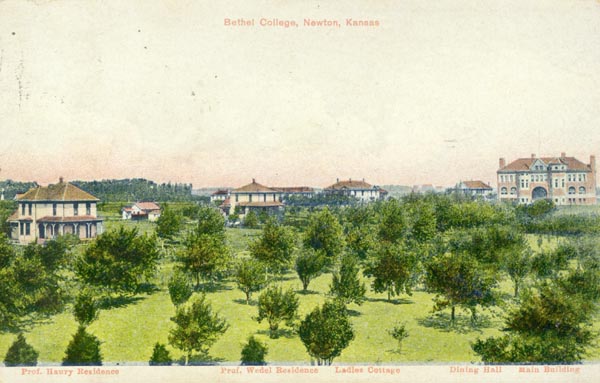
No. 1: Bird's-eye view of the campus, 1908, the Administration Building towering over
everything (No. 338, Com.)
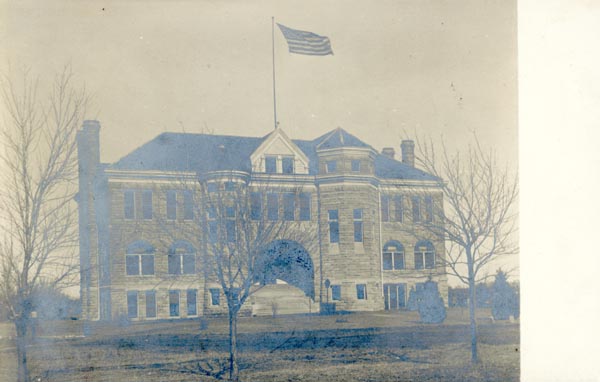
No. 2: Administration Building with the roof-mounted flag flying, 1913. The flag pole was
moved to ground level in 1934 (No. N1, RP)
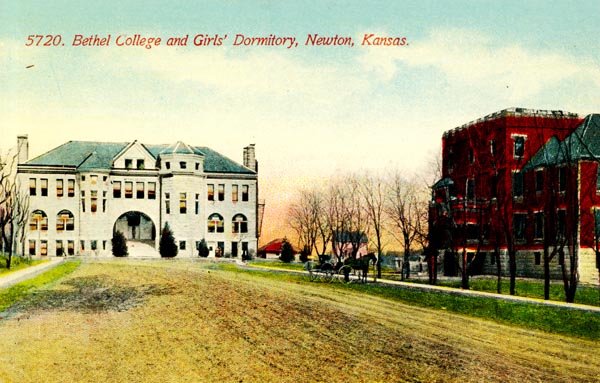
No. 3: Administration Building with Carnegie Hall to the right, about 1908. Carnegie Hall was
finished in 1908 (No. 306, Com.)
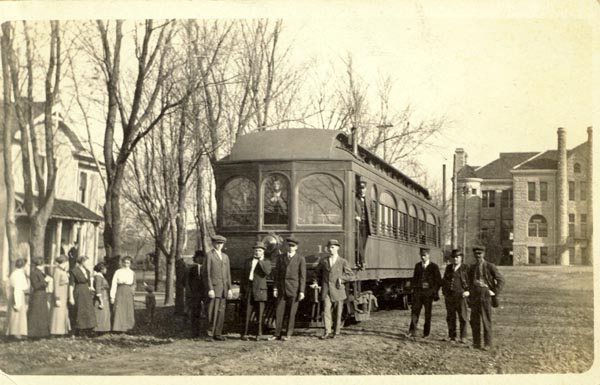
No. 4: Bethel linked and wired to the world, about 1913. The Arkansas Valley Interurban
Railroad has reached the campus, and in the background the electric wires can be seen
(No. 319. RP)
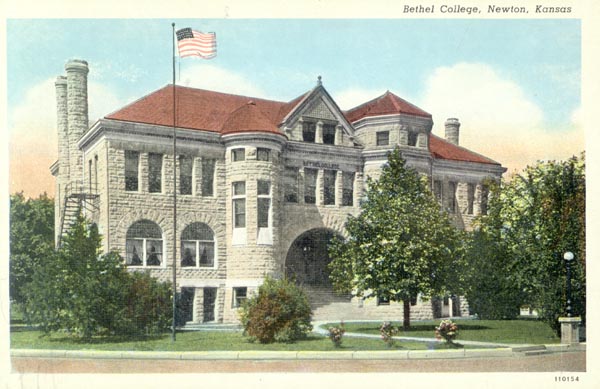
No. 5: In this view, about 1934-36, the flag pole has been moved to ground level (1934) and a
fire escape has been added (No. 308, Com.)
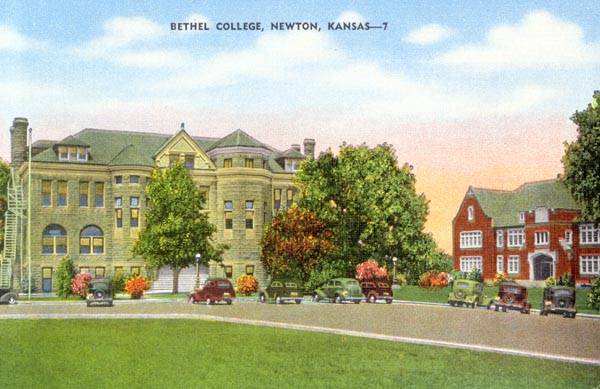
No. 6: The Administration Building with roof dormers, c. 1938, during the administration of
Pres. E. G. Kaufman. Dormers were his way of squeezing a little more usable space from
the building. The building has reached nearly its present appearance, except for glass
doors (No. 307. Com.)
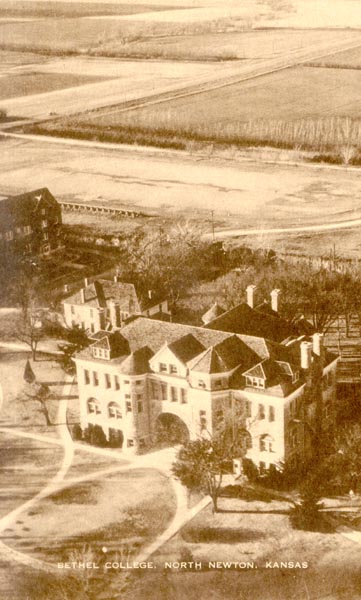
No. 7: Aerial view of the Administration Building and campus, the 1940s. In the
background are the old Dining Hall (replaced by the new library, 1948) and
Memorial Hall (1938-42). (No. 309. Com.)
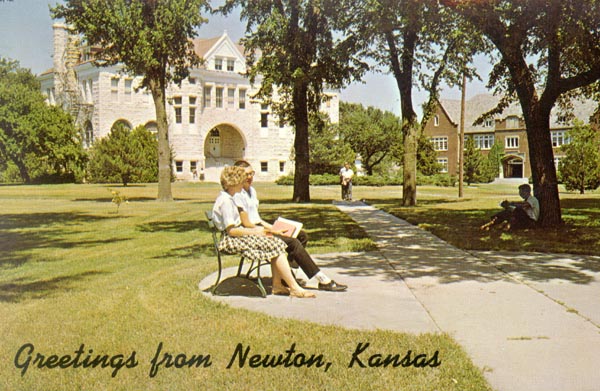
No. 8: A tourist card of the Bethel campus, "Greetings from Newton, Kansas," c. 1950. The
Administration Building has wooden doors; glass doors were added in 1965. (No. 310.
Com.)
Other campus buildings also received considerable attention in the early twentieth century, especially Carnegie Hall (1908), Alumni Hall (1914), and Science Hall (1925). The wooden buildings, of no great beauty, were not promoted on cards. After mid-century, postcards lost much of their popularity and the real photo cards disappeared entirely. Because of the decreasing use of postcards, later buildings, such as Memorial Hall, the Library, Goering Hall, Haury Hall, and the Fine Arts Center showed up on only an occasional card.
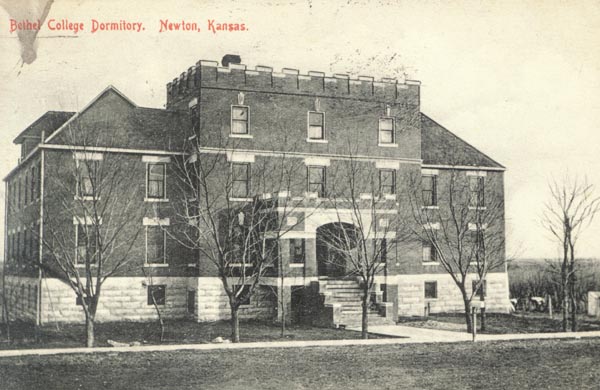
No. 9: Carnegie Hall, the ladies' dormitory, soon after completion, about 1908. It was a
formidable fortressed abode, "The Castle." (No. 315A, Com.)
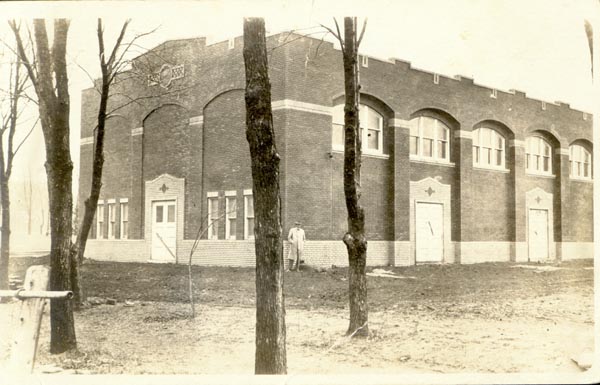
No. 10: Alumni Hall soon after completion, 1914 (No. 320, RP)
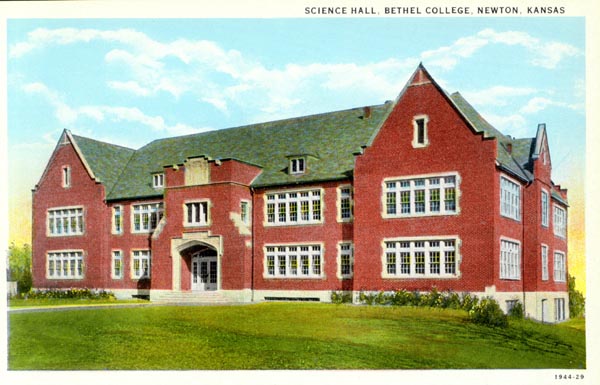
No. 11: The Science Hall, c. 1925-1930 (No. 314, Com.)
A great number of photo postcards show faculty and academic events. Most were real photo cards taken with student cameras; however, for large groups and all-campus pictures, professional photographers were likely called in.
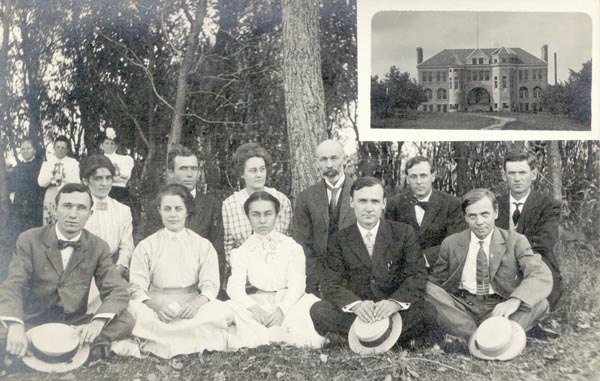
No. 12: The faculty of 1910-11, with inset of Administration Building. President J. H.
Langenwaltaer is second from right, front row (No. 323, RP)

No. 13: An all-college picnic for faculty and students, about 1910, with inset of Administration
Building (No. 328, RP)

No. 14: Art class, about 1910, Elisabeth Wirkler, teacher. She assigned students the task of
copying from popular masters of art (No. 329, RP)
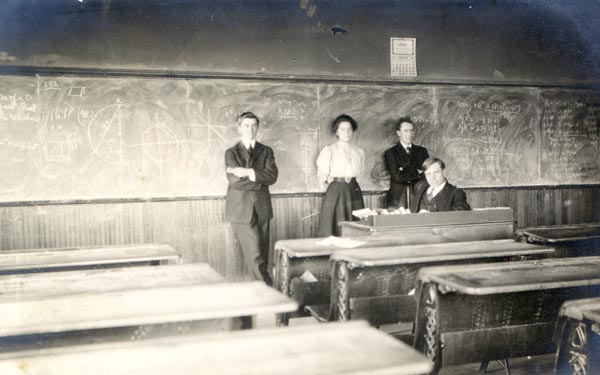
No. 15: Trigonometry class with Professor "Uncle Davy" Richert in charge, 1911 (No. N12, RP)
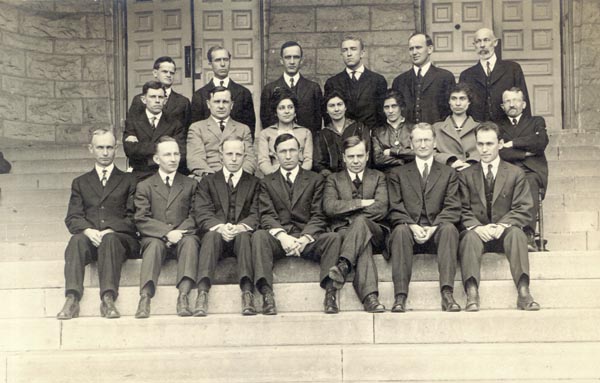
No. 16: A severe phalanx of professors-the Bethel faculty of 1915, President J. W. Kliewer is
second from right, front row (No.349, RP)
Bethel in 1912-13 enrolled 213 students. Many students were active photographers, pointing in all direction with their Kodak Brownie cameras. This section draws from the Olga Neuenschwander collection of photos and autographs from the years 1911-13. They provide a look at college life through student eyes. From her view, it seems, Bethel was mostly a place of fun and fellowship. She herself had a reputation of being jolly and great fun. Student Henry A. Fast, later professor at the college, dated her a few times; he called her a "fun person." (13) The 1913 school yearbook, along with her portrait, put these words into her mouth:
| Of all sad words of tongue or pen The saddest are these: "Can't do without men." |
Neuenschwander, or her friends (since it is not known whether she owned her own camera), photographed classes, dormitory life, social functions, chapel, and times of just having fun. She lived in the Ladies Dormitory (Carnegie Hall) and, thus, was one of the "Castle Girls." Because of its castle-like battlements and fortress appearance, it had the nickname of the "Castle" or "Irish Castle," and its inhabitants were the Castle Girls. (14) The biggest College-wide event of her Bethel years was the 1913 celebration of the college's 25th anniversary, which was duly recorded in her postcard album. Olga's main correspondents, apart from fellow students, were her brothers Milo (Bethel Academy '11) and Harry. Only a few of her cards can be shown here.
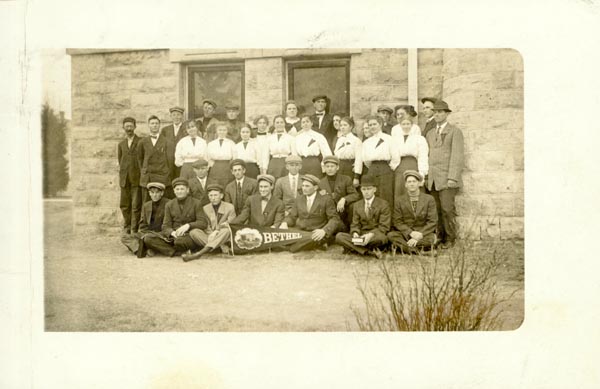
No. 17: Olga's Junior class in 1911. She is second from the right in the back row (No. N2, RP)
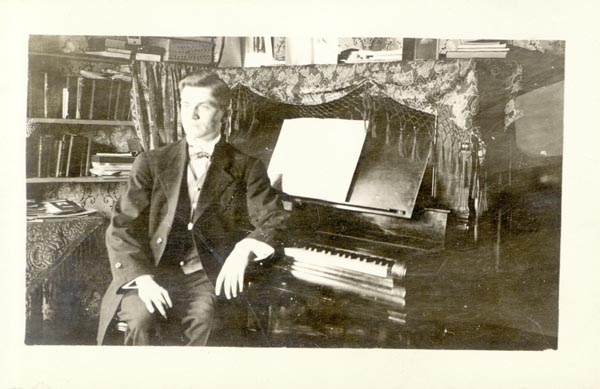
No. 18: A dapper young gentleman at the piano, identified only as "The It" (No. N18, RP)
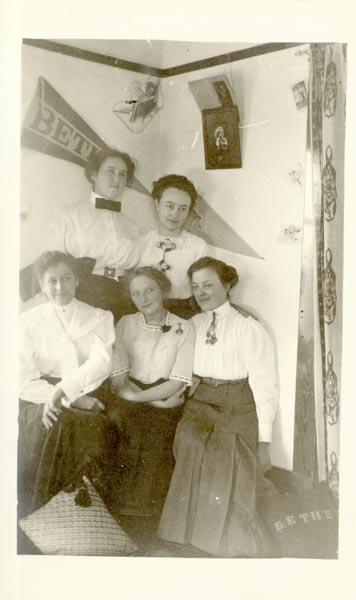
No. 19: Olga (upper left) and friends in the dormitory, with Bethel pennants and pillow
prominently displayed, 1911 (No. N26, RP)
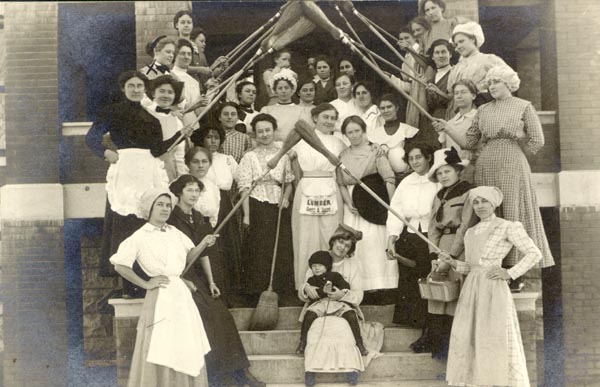
No. 20: "In Battle Array." Bethel women, on guard at Carnegie "Castle," armed with brooms and
dust pans. Olga's note: "A bunch of Bethel Dormitory Girls. . . . Your beloved onion top.
Bethel Rah Rah," Nov. 25, 1911 (No. N24, RP)
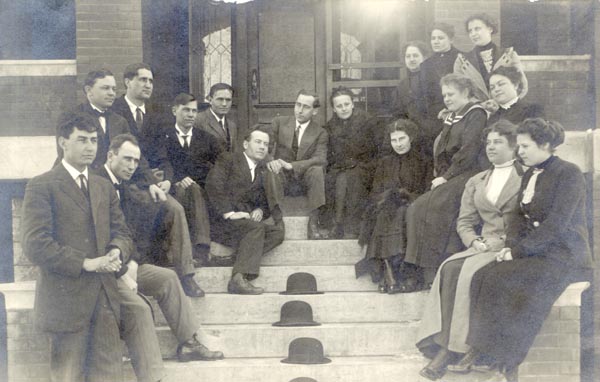
No. 21: A group of Minnesota students, men and women, with the men's hats displayed at center
point, on the steps of Carnegie Hall, 1911-12 (No. 359, RP)
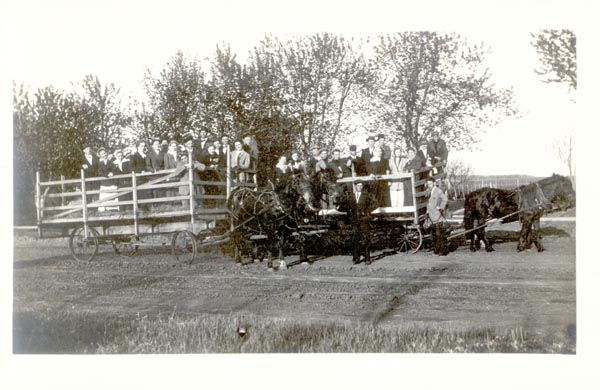
No. 22: Junior Class Hay Rack Ride - "Returning from the hay rack sport, May 1, 1912." This
was one of Olga's highlights of college, and according to the Echoes, "a never to be
forgotten ride" giving "us new life and vigor." (No. N3, RP)
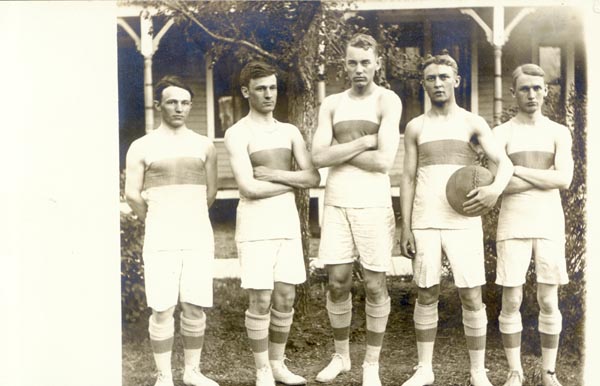
No. 23: College freshman basketball team, card from B. F. Schroeder, 1913 (No. N41, RP)
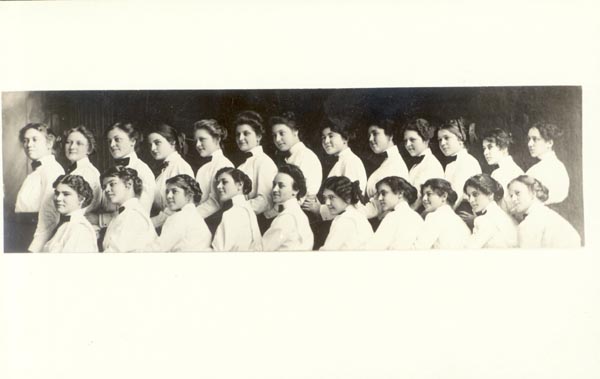
No. 24: Bethel women students, perhaps the Glee Club, Olga, upper left in second row, 1913 (No.
N55, RP)
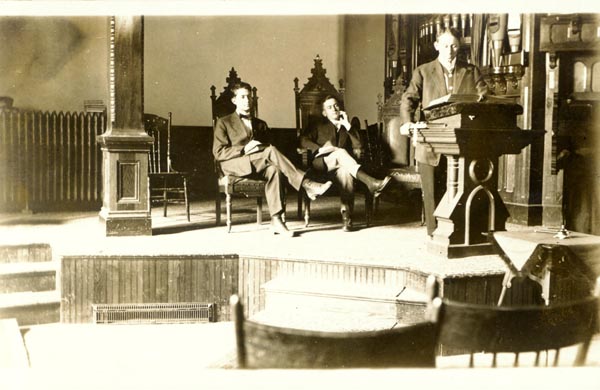
No. 25: Student-led Religious service, Arthur A. Latschar, speaker, 1913 (No. N56, RP)
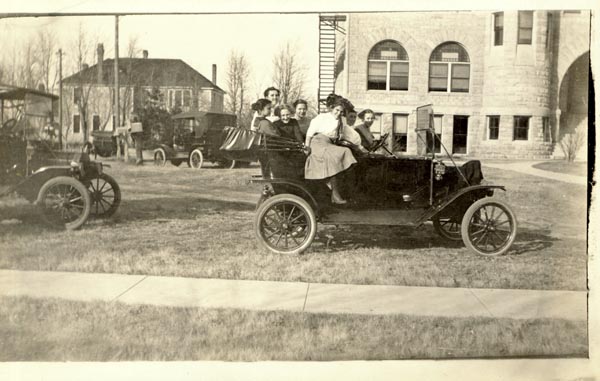
No. 26: "A Joy Ride" (the title given by the 1913 Echoes for this photo). The age of the
automobile has arrived. Olga is in the back seat. (No. N58, RP)

No. 27: Celebration of the 25th anniversary of the college cornerstone laying, 1913. (No. N4, RP)
The autograph book, which accompanied the postcard album, shows Olga's sense of school spirit and class loyalty. Students, although on the verge of the Great War of 1914-18, had thoughts of upward and forward progress. Their class motto was: "Not at the top, but climbing." Class colors were orange and black. The class yell was snappy:
In 1913, having become "The Girl Graduate," Olga returned to her hometown of Berne, Indiana. Another fellow student from Berne, Frieda van der Smissen, wrote in Olga's autograph book, "In a few weeks our class will be scattered over many states. But we will be permitted to go together to dear old Berne, to return to our dear Alma-mater in a few months." Olga went home to "dear old Berne" and lived there the rest of her life. She did not return to Bethel for the college course, as she had hoped to do. Her postcards and autographs were her mementoes.
In the past two decades, Bethel developed aggressive admissions strategies, and the "admissions postcard" was born. According to Shirley King, Dean of Enrollment Services, postcards are more important than ever these days. College materials mailed to high school seniors in sealed envelops are now so numerous--and boring--that many students hardly bother to open them. Bethel again relies heavily on postcards, which may get at least a glance from students or their parents. (15) Here are three recent examples from the past decade. Note the changing emphases as different artists or agencies took over the design.
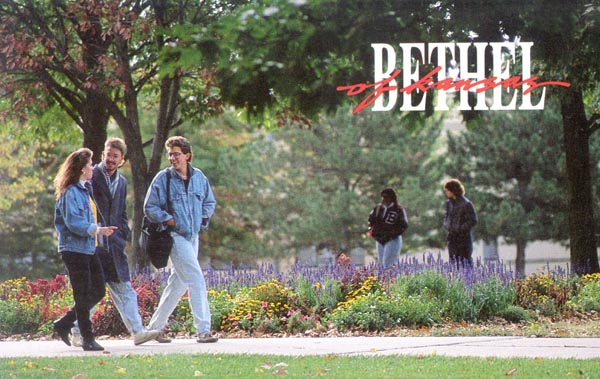
No. 28: "Bethel of Kansas," students Joy Goldsmith, Tim Gale, and John Unruh-Friesen, about
1990. Designed by Thane Chastain, photo by Mark Wiens (No. 339, Com.)

No. 29: "Open hearts open minds open doors," about 1995. This included the college telephone
number and, for the first time, the internet address (No. 365, Com.)
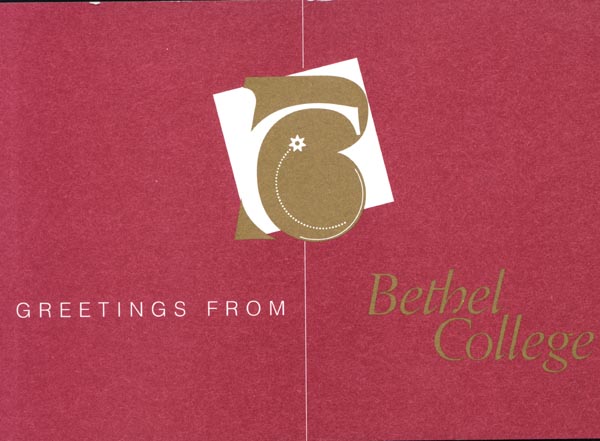
No. 30: "Greetings from Bethel College," design by Ken Hiebert, 1999- 2000 (No. 370)
The messages, always visible to the curious eyes of everyone who handled the cards, caught the flow of ordinary life. Usually no scandals or big secrets are found. Reading these cards gives a grass-roots view of history, and, the fact is, most people have very ordinary, even boring, lives. The writers never intended for the cards to be historical documents; they just wanted to send a note about what they were doing. Postcards carried messages like these: (16)
|
"Don't you think we were the candy kids at Bethel this year? I think so." c. 1911-12 (No. N9) "Mr. Rempel, my roommate. He's OK." 1910, from Milo to Olga (No. N14) "Hot! hot! here in Kansas," July 9, 1920 (No. N20) "Your cat seems to be lonesome." And "Harry lost his straw hat." c. 1913 (No. N42) "Why don't you write? We are all well. Hope you are the same," 1911 (No. 315A) "Please write as soon as you get this," 1908 (No. 338) "I am in Newton in the hospital," 1909 (No. 340) "Yes, you may go skating if you be sure to be back on time. Look under the stamp [for a secret message], 1913 (No. 249) |
Although the terse message was the rule, it was possible to cram a great deal into the little space. However, the Bethel students were always mere amateurs in this regard compared with the experts of tiny writing. Miss Rita Kittredge of Belfast, Missouri was the world champion postcard writer. One of her cards contained 15,000 words. (17)
The five themes illustrated above barely scratch the surface of possible historical topics. Postcards also tell about developments in feminism, aviation, all kinds of transportation, movies, architecture, fashion, ethnic and racial topics, advertising, and comedy. (18) Postcards reveal the spirit of the times that produced them. The postcard met the need of twentieth-century people who lacked time or inclination to compose formal letters. The twentieth-century spirit was "speed and hurry." An English newspaper of 1903 praised the postcard as "the spirit of the age-brevity and speed." (19) Most postcard themes fall into the category of social history rather than the more common political or intellectual fields of history. In the cards of the Administration Building, the changing location of the American flag, from a pole in a towering roof top position downward to ground level, suggests some revised attitudes about nationalist symbols. Photos contain many examples of automobiles, as well as other modes of transportation, and these would give much grist for study. Students discovered the excitement of "joy riding." Styles of clothing worn by Bethel faculty and students also show much change over the years. In the early photo cards, dress was formal, the men always in suits and ties, often with hats, and women in white blouses and dark skirts. By mid century, students were dressed in casual sports clothes; by late century, blue jeans, denim, shorts, and sneakers were the rule. According to Richard Carline, postcards show many social changes, not just blue jeans and shorts, but sexual, ethnic and racial developments, often in the guise of the "comic" card. Such cards aimed to amuse or titillate by showing smoking, drinking, and nudity. (20) These risque cards, however, seem to have bypassed Bethel, except for an occasional slightly raised skirt (No. 26 above).
Social historians urge that historians should tell the story of "total history" and go to the "grass-roots" to produce an inclusive picture. Postcards are a very good road into history that is inclusive of all levels of society and of all aspects of life.
Collectors consider the first two decades of the twentieth century to be the "Golden Age of Postcards," because of the tremendous profusion of cards and their esthetic quality. This was also the golden age of Bethel cards. The cards reveal two faces. One was the formal presentation of commercial postcards, where the campus and events were portrayed in the best possible light. The other face is the spontaneous picture of the real photo cards, catching people in a more natural position and being themselves. David Chien in his book About 85 Years Ago, a photo postcard essay about life in the early twentieth century, concluded that the postcards of the Golden Age showed an ordinary slice of American life from a long time ago. Admittedly, it was an era far different from our own but he saw much continuity in American life. There was much "that we may recognize as part of us still." (21) The same may be said for the Bethel postcards. The idealized postcard picture of Bethel from earlier centuries with everyone in formal costume is no longer our Bethel of today, but in the cards we recognize the continuities of the stately old buildings and many enduring qualities of scholarship and faith that are still a part of us.
1. Our thanks to Rosemary Moyer, photo librarian at the Mennonite Library and Archives at Bethel College, and Kenyon Sprunger, Berne, Indiana, for helpful information on this article.
2. Tom Phillips, The Postcard Century: 2000 Postcards and Their Messages (London: Thames and Hudson, 2000), 7.
3. Ibid., 12.
4. Richard Carline, Pictures in the Post: The Story of the Picture Postcard and Its Place in the History of Popular Art (Philadelphia: Deltiologists of America, 1972), 15.
5. Dudley Dodgion Toews, Newton Remembering Yesterday Today (Newton, 1994), see especially pp. 110-12.
6. David Chien, About 85 Years Ago: Photo Postcards from America (Circa 1907 to 1920), (Niwot, CO: Roberts Reinhart Publishers, 1997), "Real Photo Postcards," no pagination.
7. Phillips, Postcard Century, 24.
8. Naomi Lehman, Pilgrimage of a Congregation: First Mennonite Church Berne, Indiana (Berne, 1982), 269-70.
9. Obituary, Berne Witness, January 29, 1962, p. 1.
10. The donor was Jimmy Sprunger, an old friend from school days in Berne; he bought the old Stengel house for an insurance agency.
11. Our long time neighbor, Anna Claassen Linscheid (died 1986), who was a school friend of Olga Neuenschwander, had an identical book in her closet and produced it when we discussed this topic twenty years ago.
12. Peter J. Wedel, The Story of Bethel College (North Newton: Bethel College, 1954), 78.
13. Recollection of Prof. Fast, while looking over old college photos in the MLA (reported by Rosemary Moyer to the authors, January 16, 2002).
14. 1913 Echoes, caption for a photo of Carnegie women.
15. Shirley King interview, Dec. 21, 2001.
16. These captions come from a variety of Bethel and Newton, Kansas postcards (not exclusively from Olga Neuenschwander).
17. Carline, Pictures in the Post, 60.
18. Phillips, Postcard Century, 17.
19. Carline, Pictures in the Post, 57.
20. Ibid., 9-12.
21. Chien, About 85 Years Ago, back cover.
General Information
Harvey County, Kansas